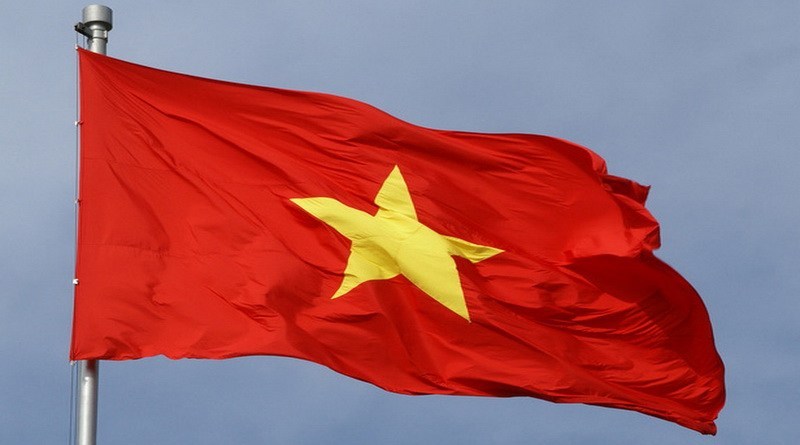
1. Many researchers believe that the history of Vietnam is a history of wars. As a historical predestination, in the long process of national development, Vietnam has had to constantly confront wars of invasion by regional powers and world empires. In the work “Unity in diversity of Vietnamese history”, History professor Phan Huy Le once concluded: Not to mention the resistance wars against invasion during the Hung King period reflected in legends, just from the resistance war against the Qin Dynasty in the 3rd century BC to 1975, the Vietnamese people had to wage 15 wars to defend the Fatherland. Of these, 12 resistance wars were victorious and 3 were defeated. The unsuccessful resistance wars led to many serious consequences for Vietnamese history, culture and society.[1].
From that summary, we see that the resistance against the invaders Trieu Da failed in 179 BC, leading to the disaster of 1,000 years of Chinese domination and it was not until 938 that independence was achieved after the Bach Dang victory led by Ngo Quyen. The Ho Dynasty's unsuccessful resistance against the Ming in 1406-1407 pushed the country into two decades of Ming domination (1407-1427). The Nguyen Dynasty's unsuccessful resistance against the French (1802-1945) and the Can Vuong movement (1885-1896) forced the Vietnamese people to suffer the yoke of French colonialism for more than 80 years (1858-1945). Those are tragic and dark pages in Vietnamese history!
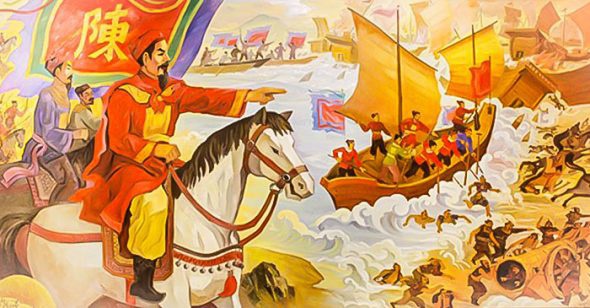
Within 30 years (1258-1288), the army and people of Dai Viet under the leadership of the Tran Dynasty had to fight three times against the expansionist and invasive ambitions of the Mongol-Yuan empire, the most powerful and aggressive nomadic force in the world at that time. Photo: Internet.
It is worth noting that, during the period of being occupied by foreign invaders, despite being exploited, suppressed, suffering many losses and sacrifices, the Vietnamese people always persistently fought to regain independence and freedom for the nation. In total, the Vietnamese people carried out more than 200 uprisings and wars of national liberation. The period of fighting against foreign invaders was up to 12 centuries, accounting for more than half of the historical period. There was almost no century in which Vietnam did not have to fight against invaders. There were periods such as the 13th century, within 30 years (1258-1288), the army and people of Dai Viet under the leadership of the Tran Dynasty had to fight three times against the expansionist and invasive ambitions of the Mongol-Nguyen empire, the most powerful and aggressive nomadic force in the world at that time.[2]In the 18th century, for 5 years (1784-1789), the Vietnamese people also had to simultaneously fight against the Qing in the North and the Siamese invaders in the South.[3]. In general, in those wars to defend the Fatherland, the invading armies were often many times stronger. Many wars also clearly demonstrated the goal of annexation and destruction, the most specific manifestation of which was the plot to assimilate and destroy cultural heritages. It can be said that in the history of Asian nations, there are few countries that have had to endure as many harsh political challenges, directly affecting the survival of the nation as Vietnam. In order to survive, develop and have enough strength to fight against foreign invaders, the Vietnamese people have gathered into a unified bloc, promoting patriotism and the awareness of protecting their territorial sovereignty and cultural identity.[4].
Obviously, the history of Vietnam cannot be just the history of wars. The history of Vietnam is also the history of a nation with many cultural creations; of economic relationships and activities; the history of the formation and transformation of social classes, of residential communities; the history of the elite and the common people, the ordinary people... all have contributed to writing the heroic pages of the nation's history in the cause of building and defending the Fatherland. The history of Vietnam is also the history of political and legal institutions; of ideological trends and movements; of religious sects and beliefs; of international and regional relations.[5]... However, war has become a constant danger and can even be considered a "typical characteristic" of Vietnamese history. That characteristic has deeply impacted the psychological life, cultural behavior, and development policies of Vietnam not only before and during the wars but also left long-term consequences in the thinking of a nation in post-war times.
2. Through the ups and downs of history, it can be seen that the 20th century was the century in which our nation had to face the most severe and fierce political challenges. In the first half of this century, Vietnam had to concentrate all its strength to fight against the war of aggression and colonial rule of the French.[6]. Vietnam won the war of national defense in the context of the Second World War coming to an end, creating favorable conditions for the Vietnamese revolution. In East Asia, the Asia-Pacific War had a strong impact on regional political life. In fact, the August Revolution in 1945 not only marked the end of more than 8 decades of French colonial rule but also ended the presence of the Japanese army in Vietnam.[7]. However, in the complex international conditions of that time, hiding under the name of the allied forces, the French political class sent troops back to Indochina, followed by the British army and Chiang Kai-shek's forces. Listening to the call "Nothing is more precious than independence and freedom" of President Ho Chi Minh, the whole Vietnamese people rose up against the invading armies[8]In that sacred and noble revolutionary cause, the role of the outstanding leader Ho Chi Minh emerged.The name of President Ho Chi Minh is associated with the most important events in the history of the heroic struggle of the Vietnamese people for freedom and independence. This struggle is an invaluable contribution to the national liberation movement and the world revolutionary process, to the consolidation of the forces of peace, democracy and social progress on our planet... Under the flag of President Ho Chi Minh, the Vietnamese people successfully carried out the August Revolution in 1945, dealing a fatal blow to the colonial system of imperialism in Asia. Under the flag of President Ho Chi Minh, the Vietnamese people established the first workers' and peasants' state in Southeast Asia - the Democratic Republic of Vietnam and defended that state during the 9-year resistance war against French colonialism.”[9].

Uncle Ho read the Declaration of Independence giving birth to the Democratic Republic of Vietnam in 1945. Photo: Internet.
During the period 1946-1954, in parallel with the armed struggle, the Ho Chi Minh government also implemented brave and clever foreign policies to gain international support and recognition. Finally, after 9 years of long and arduous fighting, with the victory of Dien Bien Phu in 1954, Vietnam restored independence to half of the country.[10].
According to the Geneva Agreement, the 17th parallel with the Ben Hai River was established as the temporary dividing line between the North and South.[11]. And the resistance war of the Vietnamese people against the invasion of the US and its "allied" countries had to last 21 years (1954-1975) to achieve final victory. However, after that, the wars to protect the southwestern and northern borders took place. For about 10 years, Vietnam had to go through extremely difficult days in terms of politics, economy and diplomacy, cultural development and maintaining social stability.
Thus, like the 13th and 15th centuries, the 20th century was a century in which the Vietnamese people had to face many harsh political challenges. The survival of the nation was seriously threatened. There had never been a century in which so many foreign invaders appeared simultaneously on Vietnamese territory. And there had never been a century in which the Vietnamese country had to suffer so many sacrifices and losses! However, Vietnam stood firm, gradually revived and developed after the wars. It was a great revival of a nation with strong cultural vitality. In some aspects, the harsh challenges of history have forged the character, fostered patriotism, the desire for peace, and reached prosperity in each citizen and the entire Vietnamese nation.
War is the most fierce and comprehensive challenge to the vitality of a nation. To fight and defeat a fierce enemy, many times stronger in military force, the Vietnamese people had to mobilize all resources to the highest level for the cause of liberating the South and unifying the country. A "People's War”[12], the "Holy War"was organized to protect the most sacred values of the nation. In that heroic resistance war, patriotism and the spirit of national independence were highly demonstrated in all aspects of social life. The entire Vietnamese people were united and determined to protect the original cultural values of the country, to protect sovereignty and the integrity of national unity. Vietnam has won the strong support of peace-loving people around the world.[13]During that arduous 21-year journey, the strength of the nation and the strength of the times converged, creating a great strength leading to the victory of the Spring of 1975.
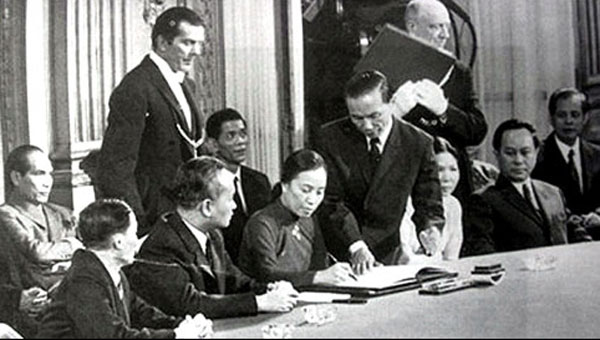
Ms. Nguyen Thi Binh - Head of the delegation of the Provisional Revolutionary Government of the Republic of South Vietnam (middle) signed the Paris Agreement on ending the war and restoring peace in Vietnam in 1973. Photo: Internet.
3. After the fierce challenges of the wars passed, by the 1980s, the domestic and international situation had fundamental changes. Realizing that it was impossible to continue maintaining the management policies and thinking, the "traditional" foreign views of the Cold War period, under the leadership of the Party, Vietnam carried out the Doi Moi process since 1986, with the first breakthrough policy being to abolish the subsidized bureaucratic mechanism and implement a socialist-oriented market economy policy. As a country whose economic potential mainly relies on agriculture, Vietnam has implemented many open policies in agriculture, at the same time outlining the development trend for economic sectors, for scientific and technological activities, education and culture.[14]. As a result, after only a short time, from a place of food shortage and constant hunger, Vietnam was able to fundamentally solve the food problem and become one of the countries with rich food potential, capable of exporting a large amount of agricultural products to the world market. Along with crude oil and agricultural products, rice has become an important export, bringing foreign currency for socio-economic development, stabilizing the lives of more than 80% of the rural population and contributing to the construction of a number of new industries and economies in Vietnam.[15].
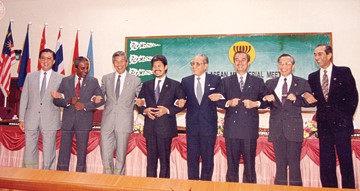
Former Deputy Prime Minister and Foreign Minister Nguyen Manh Cam (second from right) with ASEAN Foreign Ministers at the meeting to admit Vietnam into ASEAN in Brunei in 1995. Photo: Internet.
In addition, during the implementation of the Renovation policy, Vietnam's awareness of the political context and world power also had fundamental changes. In about 10 years (1986-1995), Vietnam made many outstanding efforts to resolve the existing problems and difficulties in international relations. From the policy of "Want to be friends with all countries" to the motto: "Vietnam is ready to be a friend and reliable partner in the international community, striving for peace, independence and development.”[16], Vietnam sent a message of peace, expressed its goodwill to build, consolidate and develop cooperative and friendly relations with peoples around the world and in fact wrote a new page in international relations. That peaceful, proactive and active foreign policy of dialogue has raised Vietnam's position in the international arena. Implementing an increasingly open foreign policy, regional and world countries also understand more and understand more correctly about Vietnam. Entering the 1990s, together with the joint efforts of the international community, Vietnam successfully resolved the "Cambodia issue", continued to consolidate the special friendship with Laos, gradually improved relations with ASEAN countries and importantly, achieved many important steps in normalizing relations with China and improving relations with the US.[17]. With China, after many efforts, in March 1991, Chinese Prime Minister Li Peng declared that "Vietnam-China relations have thawed". By November 1991, the leaders of the two countries officially announced the normalization of relations. For the countries in the Northeast Asia region, Vietnam continued to strengthen its special relationship with Japan and in 1992 officially established state-level diplomatic relations with South Korea.[18].
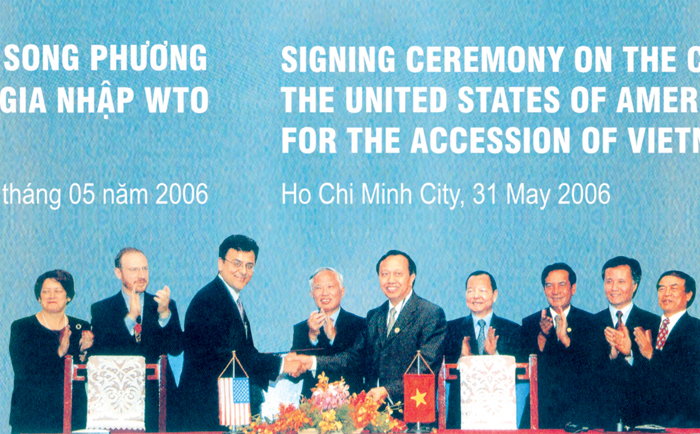
Mr. Luong Van Tu and Mr. Batia - Head of the US delegation - signed the bilateral agreement on WTO accession on May 31, 2006 in Ho Chi Minh City, with the participation of Deputy Prime Minister Vu Khoan, Mr. Le Thanh Hai - Secretary of the Ho Chi Minh City Party Committee, Mr. Le Cong Phung - Deputy Minister of Foreign Affairs, Ms. Surance - Chief Representative of USTR. Photo: Internet.
In the historical journey since the implementation of the Doi Moi policy, there were two important moments: 1995 and 2006. The year 1995 was the year of many important turning points in Vietnam's foreign relations. Some commentators believe that it was a year of great victory for Vietnam in terms of foreign affairs. That year, on July 28, 1995, Vietnam officially became the seventh member of ASEAN. Also in this year, after the order to lift the embargo against Vietnam issued on February 3, 1994, on July 11, 1995, US President Bill Clinton officially announced the normalization of relations with Vietnam. With those important diplomatic victories, a period of Vietnam's isolation and blockade in international relations ended. In fact, Vietnam had more favorable opportunities to integrate with the common developments of the region and the world.
A decade later, in 2006, Vietnam continued to achieve two more important diplomatic victories: becoming an official member of the World Trade Organization (WTO) and successfully organizing the APEC Conference in Hanoi. During this year, Vietnam-Japan relations were elevated to a strategic level. Relations with China and the United States also saw many important improvements. With China, the two countries resolved two of the three fundamental problems in bilateral relations.[19]A new wave of investment has focused on Vietnam, a country rich in potential resources, human resources... Vietnam has become an attractive investment environment for many businessmen, economic groups, banks and large financial institutions in the world.
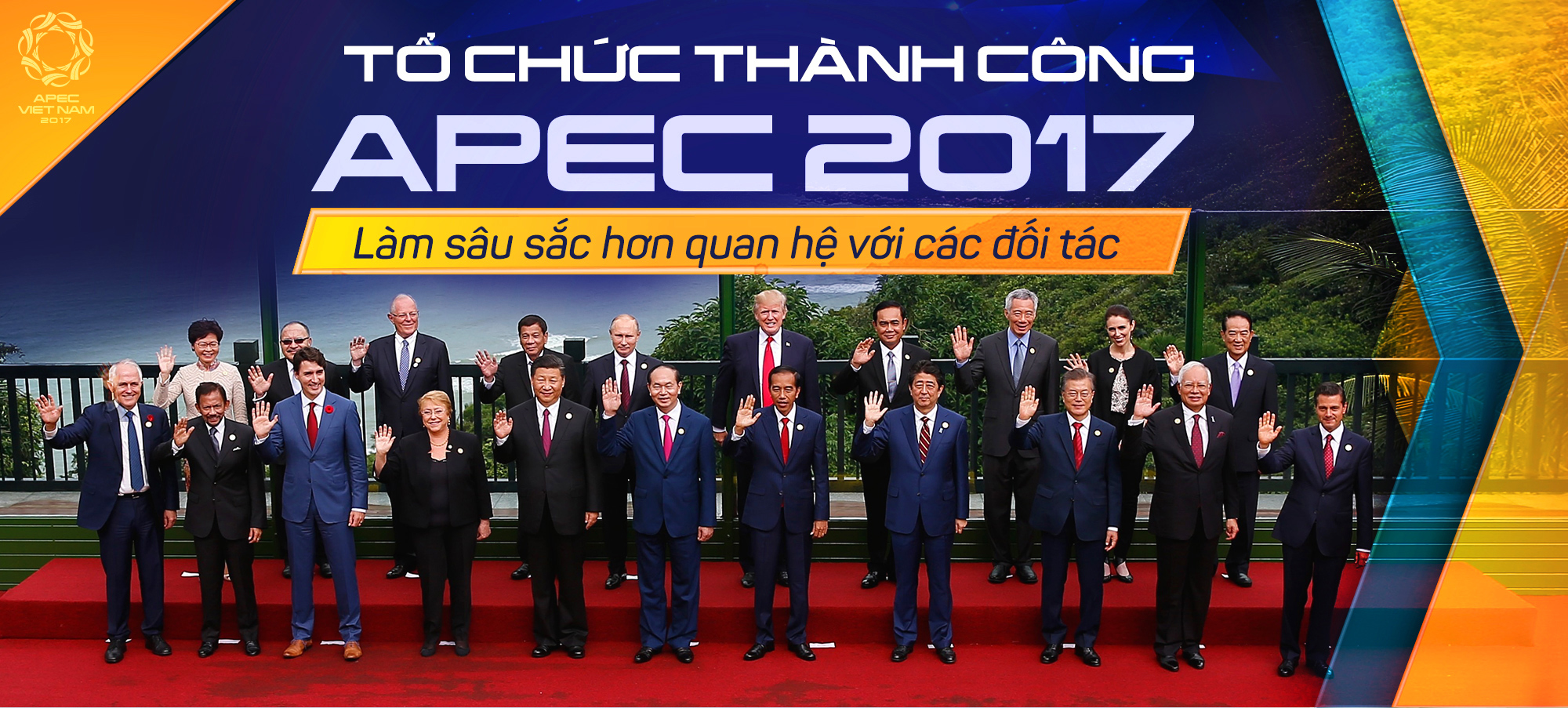
Vietnam successfully organized the APEC Summit in 2017. Photo: Internet.
From the reconstruction of the basic appearance and historical developments of the 20th century, some observations and interpretations can be drawn:
1. Vietnam's strategic location
In fact, to thoroughly answer the question of how Vietnam's strategic position has played a role and manifested itself through historical periods and in the nation's long historical journey is not an easy task. Because like many countries in the world, Vietnam's geo-strategic position has constant, unchanging factors but also variable factors, that is, there is a shift over time by domestic, regional and international factors. It can be seen that, along with the potential and rich resources of the Tropical Universal Ecosystem (General ecosystem), abundant labor resources, relatively large deltas, many commercial ports favorable for implementing military defense plans and promoting the development of international trade... the location of communication and transfer between Northeast Asian countries and Southeast Asian countries, between the continent and the ocean shows the importance of Vietnam on the regional political map.[20]. In the article, “Vietnam's Geopolitics from Asia: What Lessons from the Third Indochina War for Today??”, researcher Christoper Goscha said: “Vietnam has been and will always be a country with an extremely important geopolitical position in the world due to Vietnam's geographical position on the Eurasian continent and because Vietnam is adjacent to the East Sea regions”. Putting Vietnam in the relationship and the struggle for influence between Asia and the world, we can see that although in terms of territory, Vietnam is only a relatively small country, from history to today, Vietnam “has always held an important position not only for the Americans but also for the Russians, the Chinese, the Japanese, and even the Indians”.[21].
Stretching along the eastern slope of the Southeast Asian peninsula, with a coastline of 3,260 km, Vietnam holds a junction between peninsular Southeast Asia and island Southeast Asia, between Northeast Asia and Southwest Asia... Vietnam is the destination of many migration flows, the intersection of many cultures in the Southeast Asian region as well as between Southeast Asia and China and India. As many researchers have pointed out, historically, if the influences of India were transmitted to Southeast Asia through economic, cultural and religious routes - the peaceful route, then the peoples in the region, especially the countries sharing land borders and important maritime trade positions in East Asia, were subject to frequent and strong political and military pressure from the North.
As a country that holds a position of intersection between two worlds: Northeast Asia and Southeast Asia, it seems that Vietnam is always the first country to bear strong pressure from the North and some forces from the Southern and Southwestern border regions. In the process of expanding its influence to the South, Vietnam is the country that holds the position of gateway on the way to Southeast Asia of many Northern monarchies because this is the connection point for both land and sea traffic. In the modern era, Western powers (Portugal, Spain, England, Netherlands, France...), from the Southern sea, wanting to penetrate the Southeast Asian peninsula and the large market area of Southern China, also considered Vietnam an important target to conquer. Objectively speaking, Vietnam's geo-strategic position always accommodates and creates many objective favorable conditions for our country to develop its economy, expand diplomatic relations, cultural exchanges... but that position also easily turns Vietnam into a target and a disputed area of regional and international powers.[22].
2. About the origin and strong vitality of the nation
As presented above, if we count from the invasion of the Qin Dynasty in the 3rd century BC to 1975, within 22 centuries, Vietnam had to conduct 15 resistance wars to defend the country and the time to fight against foreign invaders was up to 12 centuries.[23]. As an early-formed nation in Southeast Asia, the residents of the Van Lang and Au Lac states were soon aware of their own living environment, living space and distinct culture. During the 1,000 years of Chinese domination, along with the process of "Sinicization" is a process of cultural self-defense: "de-sinicization”. Some authors argue that the process of “Sinicization" only occurred strongly in some upper social classes and concentrated in the Northeast region. The density of the system of Han tombs and Han-style tombs as well as the capitals in this area partly proves that point of view. Therefore, although dominating Vietnam for a relatively long time, in general, the influence of Northern culture could not reach too far beyond the scope of the Red River Delta and some areas with indigenous cultural layers, which shared many influences of Southeast Asian culture. However, over time, through many different paths and methods, that culture has had certain permeations into the cultural life of many social classes. During a thousand years of Chinese domination, it is difficult to imagine that Northern culture could not penetrate some rural areas. In fact, some cultural elements, customs, and practices from the North and even from the South have gradually permeated and become a part of Vietnamese culture, especially with the upper class of society
Besides, it must also be seen that, in the villages and remote areas, the traditional cultural elements of ancient Vietnam, which are close and have the same foundation as Southeast Asian culture, are still preserved as a stable nuclear structure. The key point is that, although the pressure of Chinese culture is very strong and the influence of this culture is continuous, it has not been able to degrade or destroy the traditional structure. The deep awareness of origin, of territorial sovereignty and a unique cultural tradition is the endogenous strength, the fundamental factor to both localize the external cultural elements and preserve that structure. That structure is also preserved in the close relationship between village members, in cultural habits, activities and common sense, deep sense of community. That consciousness is the sacred link between social members and can become the factor of aggregation, the driving force to transform intoNationalism,Patriotismand that patriotism is always multiplied when national interests and sovereignty are threatened.
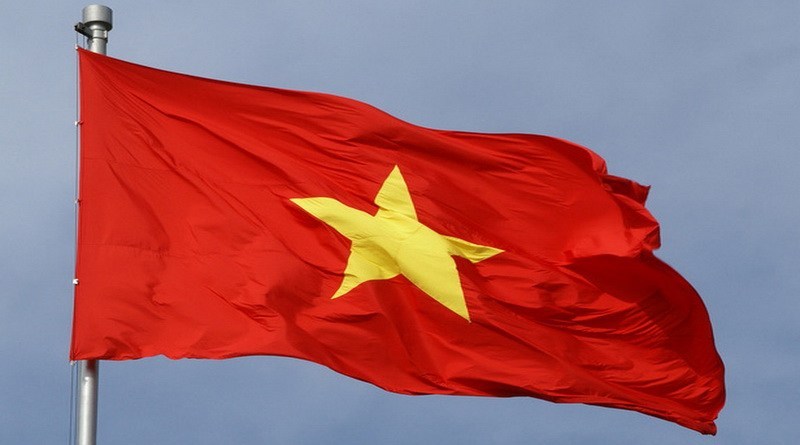
Furthermore, if we look at the process of cultural exchange along the North-South axis and from the perspective of cultural analysis and cross-section, we can see that the influences from the North on Vietnam can be divided into three basic types or circles. First, there are the influences from the South China cultural region that spread to Southeast Asia and Vietnam. Next, there are the influences from the North China, and finally there are the influences from the North China but have been "Southernization”. In which, the first cultural circle is somewhat close to Southern culture, so when it penetrated Southeast Asian society - Vietnam, in general, there were no strong reactions.
Importantly, while resolutely fighting to protect political independence, in terms of culture, Vietnam did not reject many foreign cultural values. With the viewpoint of "No Chinese, no different from China” (No less than China, no different from China) generations of Vietnamese people have found in the regional cultural treasure the capacity for creative development and are ready to accept those heritages to not only supplement but also strengthen their necessary resistance. In fact, in the Vietnamese cultural tradition from political institutions, laws, writing, education... there are many regional cultural imprints. In the workSome thoughts on Vietnamese history and Vietnamese ideology, historian Ha Van Tan once said: "In the history of Vietnamese ideology, there is often the need to hone existing ideological weapons to suit Vietnam's needs, of which the greatest and most urgent need is to preserve the nation's survival."[24].
It is also necessary to add that the strength of Vietnamese culture is also the synthesis of the influences of Indian civilization, especially the humanistic thoughts and views of Buddhism and Hinduism.[25]Based on the indigenous cultural foundation and a deep sense of national sovereignty, Vietnamese culture has absorbed many values and elements of Northeast Asian and Southwest Asian civilizations, and from the 16th to 17th centuries, the influences of Western culture to supplement and increase the value and creative vitality of its culture.[26]. It can be said that Vietnamese culture found its endogenous capacity and strong vitality in the process of fighting for national independence and really started after 10 centuries of Chinese domination. That explains why, just a short time after gaining independence, with the belief in the nation's longevity, with its new position, vision and vitality, Dai Viet became a powerful country in Southeast Asia.
Throughout 1,000 years of Chinese domination, 10 centuries of resistance against foreign invaders, defending independence, sovereignty and building the country, the Vietnamese people have demonstrated strong political will, strong cultural identity, resilience and intelligence. Thinking about the historical and cultural journey of the nation, we can understand:Cultural identity is the crystallized, core values of a culture; those values are formed over time, refined through cultural eras, passed down through many generations and thanks to that cultural identity, people can recognize the similarities, differences, contributions, unique values and creative capacity of a culture in the totality of cultures and human civilizations..
3. Vietnam - Dynamic country
Some researchers believe that Vietnam is an agricultural country, Vietnamese culture is an agricultural culture. Agriculture is the characteristic and identity of Vietnamese - Southeast Asian culture. But on the other hand, we also see that Southeast Asia is not a region or center with a homogeneous natural ecosystem and culture.[27]. Southeast Asian culture is a complex and each culture in the region contains and interweaves many different traditions. Vietnamese culture is a unified culture in diversity. The process of territorial expansion and the exploitation of the Central strip of land and the Mekong Delta by the Vietnamese people has gradually converged into a multifaceted cultural tradition of the regions with three basic foundations: Dong Son culture in the North, Sa Huynh - Champa in the Central region and Oc Eo - Phu Nam in the South of Vietnam. The natural conditions of being located on a peninsula and being a country with a high coastal index are also one of the reasons for the dynamic development in the historical journey of the nation.[28].
Being governed by a complex ecosystem, being a multi-ethnic country, Vietnamese people worship polytheism. This is the core factor, creating the typical cultural behavior, tradition of Vietnam. That explains why, when new cultural and religious elements penetrate Vietnamese society, naturally, the indigenous culture can accept and often does not have major, fierce cultural conflicts. Cultural tolerance and the spirit of turning that tolerance into thinking and action in cultural behavior is one of the unique values of Southeast Asian culture and Vietnamese culture.
Over the past decades, people have increasingly talked about Asian values. Those values are expressed and crystallized in the thoughts and philosophies of Buddhism, Hinduism, Confucianism, Islam, etc.; in the close relationship between humans and the social, cultural environment and the natural world; in the characteristics of Asian social structures and community organizations; in the order and emotional attachment and transmission between family members, etc. Those values are the synthesis of the most quintessential and humane values of humanity, penetrating time and space, and present in the strategies of many countries today that are aiming for green and sustainable development.
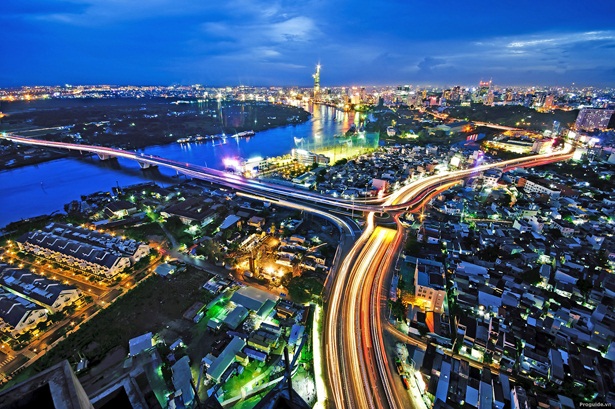
Ho Chi Minh City - one of the most dynamically developing cities in the country. Photo: Internet
Many cultural researchers believe that in traditional Vietnamese culture, the Vietnamese are sentimental, even sentimental, people. I think that is true but not enough. The Vietnamese are also rich in practical thinking, value practical values and have a high ability to adapt to each specific political environment. With their thinking and reason, the Vietnamese have organized social forces to build large-scale irrigation systems. The Vietnamese have also organized many major battles of strategic significance with high military art and won important victories against powerful enemies. With practical thinking, the Vietnamese have also been determined to abandon old institutions, methods and policies of economic and social management to implement reform policies in history and Doi Moi in modern times. With practical thinking, they also know how to change the “traditional” foreign policy, shifting from unipolarity to multipolarity, multilateralizing international relations to share benefits and keep pace with the progress of humanity. During the Renovation period, Vietnam has successfully resolved many complicated relationships, shifting from confrontation to dialogue for the common prosperity and development of the region. Vietnam cannot (and will not) be pushed, turning itself into a “battlefield” or a “powder keg” hidden in Asia.[29]In the trend of dialogue and cooperation, Vietnam has proactively closed many past sorrows to look to the future, not missing great opportunities for the cause of national revival.
In fact, Vietnam's Doi Moi is not an adjustment or change of some specific policies but rathera comprehensive innovation processhas a turning point meaning in determining a new path for the nation. That path is consistent with the country's aspirations to rise, with historical reality and the new international context. A new development model towards integration is being established in Vietnam.[30].
A confident, dynamic, creative Vietnam, adapting to the rapid developments of human civilization is becoming a common and inevitable trend. Vietnam is striving to become a creative, entrepreneurial country and an active member, proactively grasping the trends of the world, of the Fourth Industrial Revolution.[31]. Looking at the Fourth Industrial Revolution with positive aspects, Klaus Schwab - Founder and Executive Chairman of the World Economic Forum said: “Shaping the Fourth Industrial Revolution to ensure that it is empowering and human-centered, rather than divisive and dehumanizing, is not the task of any single subject, field, region, industry or culture. The profound and global nature of this revolution means that it will impact and be influenced by every country, every economy, every sector and every person. Therefore, it is urgent that we pay attention to investing and devoting enthusiasm to multi-stakeholder and cross-sectoral cooperation, across academic, social, political, national and professional boundaries. We need these coordinated and interactive efforts to build positive, universal and hopeful scenarios that allow individuals and groups from all over the world to participate. participate in and benefit from the ongoing transformations”[32].
After more than 3 decades of Renovation, Vietnam truly wishes to be a responsible member of the world community, and has been making positive contributions to the cause of peace, strengthening cooperative and friendly relations, for the prosperity of the country as well as of Asian and world countries in the 21st century.
[1]Phan Huy Le:Unity in diversity of Vietnamese history, in: Searching for the origin, Volume 1, The Gioi Publishing House, H., 1998, p.495.
[2]Ha Van Tan - Pham Thi Tam:The resistance against the Yuan-Mongol invasion in the 13th century, Social Sciences Publishing House, H., 1970.
[3]Phan Huy Le - Bui Dang Dung - Phan Dai Doan - Pham Thi Tam - Tran Ba Chi:Some strategic battles in national history, People's Army Publishing House, H., 2004.
[4]Phan Huy Le:Vietnamese History and Culture - Partial Approach, World Publishing House, H., 2012; Vu Minh Giang:Traditional and modern Vietnamese history, Education Publishing House, H., 2009.
[5]Nguyen Van Kim:Cultural assimilation and integration in Vietnam, Publishing House. Hanoi National University, H., 2016, pp.83-119.
[6]Dinh Xuan Lam:Anti-colonialism movement in Vietnam, Education Publishing House, H., 2015; Nguyen Manh Dung:The process of French invasion into Vietnam from the late 17th century to the mid-19th century - Causes and consequences, Publishing House. Hanoi National University, H., 2016.
[7]During the occupation of Vietnam (1940-1945), along with military actions, the economic policy of the Japanese military occupation force is also considered one of the main causes leading to the disaster that caused more than 2 million people to starve to death. See Van Tao - Furuta Motoo:The 1945 Famine in Vietnam - Historical Evidence, Knowledge Publishing House, H., 2011.
[8]Vu Duong Ninh:Vietnamese Revolution on the International Chessboard - History and Issues, National Political Publishing House, H., 2016, pp.39-48; Pham Hong Tung:History of the August Revolution of 1945 in Vietnam, Publishing House of Hanoi National University, H., 2013; Many authors:Ho Chi Minh - An Asian of all time, National Political Publishing House, H., 2010.
[9] Statement of the International Conference “Vietnam and the World” commemorating the 90th anniversary of President Ho Chi Minh's birth, in: Vietnam and the world, Truth Publishing House, H., 1981, pp.202-212.
[10]JC Rome:1954 - A year of change; in University of Social Sciences and Humanities, VNU Hanoi: Dien Bien Phu from the perspective of Vietnamese - French scientists, National Political Publishing House, Hanoi, 2005, pp.20-26.
[11]In the complex international conditions at that time, Vietnam could not be completely proactive in making diplomatic decisions. In fact, the agreement was an arrangement of interests to achieve a balance of power among major countries. In Vietnamese history, with the signing of the Geneva Agreement, Vietnam's territory was divided for the second time (21 years), after the first division that took place during the Trinh - Nguyen conflict that lasted 114 years (1672-1786). See Mitchell K. Hall:Because of Their Faith - Calcav and Religious Opposition to the Vietnam War, Columbia University Press, 1990; Larry Berman:No Peace, No Honor - Nixon, Kissinger, and Betrayal in Vietnam, Library of Congress Cataloging-in-Publication Data, America, 2002; Pierre Asselin:A Bitter Peace – Washington, Hanoi, and the Making of the Paris Agreement, The University of North Carolina Press, 2002.
[12]The basic content and spirit of this concept were first put forward by President Ho Chi Minh in his Call for National Resistance in December 1946. Later, General Vo Nguyen Giap continued to develop the ideology and complete the theory of this concept.
[13]The national spirit and deep awareness of national independence and unity, according to Vietnamese historians, are very typically expressed in the work.Proclamation to the soldiersof Tran Hung Dao (1226-1300),Proclamation of Victory over the Wuof World Cultural Celebrity Nguyen Trai (1380-1442) andDeclaration of IndependencePresident Ho Chi Minh (1890-1969) excellently inherited a number of ideas expressed inDeclaration of Independenceof America in 1776 andDeclaration of the Rights of Man and of the Citizenof the French Revolution of 1791.
[14]Dang Phong:“Breaking Barriers” in Economics on the Eve of Innovation, Knowledge Publishing House, H., 2009; Dang Phong:Vietnamese economic thinking 1975-1989, Knowledge Publishing House, H., 2009; Vu Cao Dam:Paradox and the way out - Discussing the philosophy of developing science and education in Vietnam, World Publishing House, H., 2014.
[15]Vietnam's food production has steadily increased from 17.5 million tons in 1987 to 34.3 million tons in 1999, doubling in 13 years. From an average of 1 million tons of food imported each year, in 1989 Vietnam began exporting 1.4 million tons of rice and by 1999 it had increased to 4.5 million tons, ranking second in the world in rice exports, after Thailand. See Pham Xuan Nam:Socio-economic innovation in Vietnam (1986-2000) - An overview; in: Vietnam in the 20th century, Volume I, National Political Publishing House, Hanoi, 2001, p. 237.
[16]Communist Party of Vietnam:Documents of the 9th National Congress of Delegates, National Political Publishing House, H., 2006, p.119.
[17]By the end of 1989, Vietnam had withdrawn all its troops and experts from Cambodia. In the face of the general détente trend, the US also adjusted its policy towards Indochina, ending its support for the Cambodian coalition government and starting negotiations with Vietnam on normalizing US-Vietnam relations. See Nguyen Dinh Bin (Cb.):Vietnamese diplomacy 1945-2000, National Political Publishing House, H., 2005, p. 334.
[18]Vietnam-Japan friendship relations were officially established on September 21, 1973, just eight months after the Paris Agreement on ending the US war in Vietnam was signed (January 27, 1973). See Shiraishi Masaya:Japan - Vietnam Relations 1951-1987, Social Sciences Publishing House, H., 1994, pp. 89-95. Although the Vietnam - Korea relationship was established relatively late, according to observers, the development speed of this relationship is extremely fast and has many prospects in the future due to the cultural similarities between the two countries and the favorable investment environment with great potential of Vietnam.
[19]Along with signingLand Border AgreementOn December 30, 1999 and December 25, 2000, the governments of Vietnam and China also signedAgreement on the delimitation of the Gulf of TonkinandAgreement on Fisheries CooperationThus, according to the assessment, Vietnam has completely resolved two out of three remaining territorial border issues with China including: Land border, Gulf of Tonkin delimitation and East Sea issue.
[20]Herodotus:The Importance of Vietnam's Geopolitics, National Political Publishing House, H., 2018, pp.48-53.
[21]Herodotus:The Importance of Vietnam's Geopolitics, National Political Publishing House, H., 2018, p.26.
[22]Robert D. Kaplan:Suhbrightgeographical definition(Translated by Dao Dinh Bac), Writers Association Publishing House, Hanoi, 2017, pp.72-74.
[23]Phan Huy Le:The process of formation and development of the Vietnamese people; in: Searching for the origin, The Gioi Publishing House, H., 1998, p.465.
[24]Ha Van Tan:Some thoughts on Vietnamese history and Vietnamese ideology; in: Coming to Vietnamese cultural history, Publishing House of Writers Association, H., 2005, p.50.
[25]Tran Van Giau:Traditional spiritual values of the Vietnamese people, National Political Publishing House, H., 2011, pp.121-125.
[26]Phan Huy Le:Cultural contact with France and the West in the process of modernization in Vietnam, in: Vietnamese History and Culture - Partial Approach, World Publishing House, H., 2012, pp.1004-1016; Trinh Van Thao:Three generations of Vietnamese intellectuals (1862-1954), World Publishing House, 2013; Nguyen Van Khanh (Cb.):Vietnam's Intellectual Resources: History, Current Status and Prospects, National Political Publishing House, H., 2012.
[27]Tadao Umesao: An Ecological View of History - Japanese Civilization in the World Context, Trans Pacific Press, Melbourne, 2003; Arnold Toynbee: A Study of History - A New Edition Revised and Abridged, 1972.
[28]Keith Weller Taylor can be seen at:The Birth of Vietnam, University of California Press, 1983, p.7 and profound analysis by Professor Tran Quoc Vuong on the adaptability of factorsWatersuch as project:A characteristic of Vietnamese culture: The ability to adapt; in: Vietnamese culture: research and reflection, National Culture Publishing House, Hanoi, 2000, pp.41-49.
[29]University of Social Sciences and Humanities, VNU:Vietnam in the process of national unification, innovation and integration, Publishing House of Vietnam National University, Hanoi, 2005;Vietnam after 30 years of Renovation – Achievements and prospects, Hong Duc Publishing House, H., 2017; Vu Duong Ninh (Cb.):Vietnam in a changing world, Publishing House. Hanoi National University, H., 2017; Nguyen Quoc Hung:With the 20th century, World Publishing House, H., 2016.
[30]Phung Huu Phu - Le Huu Nghia - Vu Van Hien - Nguyen Viet Thong (Co-Cb.):Some theoretical and practical issues on socialism and the path to socialism in Vietnam over 30 years of renovation, National Political Publishing House, H., 2016.
[31]Vu Van Phuc - Pham Minh Chinh (Cb.):International economic integration 30 years in review, National Political Publishing House, H., 2015, pp.9-23, 280-292; Dao Thanh Truong (Cb.):Science, Technology and Innovation System in Vietnam in the Trend of International Integration, World Publishing House, H., 2015, pp.55-70, 71-78.
[32]Klaus Schwab:The Fourth Industrial Revolution, World Publishing House, H., 2016. pp.12-13.
Article posted onCommunist Magazine, sNo. 923 (8-2019), pp.53-59.
Author:Prof. Dr. Nguyen Van Kim